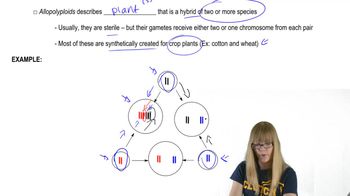Here are the essential concepts you must grasp in order to answer the question correctly.
Nondisjunction
Nondisjunction is the failure of homologous chromosomes or sister chromatids to separate properly during cell division. This error can lead to an abnormal number of chromosomes in the resulting gametes. In the case of Down syndrome, which is caused by an extra copy of chromosome 21, nondisjunction often occurs during meiosis in the mother, resulting in a gamete with an additional chromosome.
Recommended video:
Maternal Age Factor
Maternal age is a significant risk factor for chromosomal abnormalities, including Down syndrome. As women age, the likelihood of nondisjunction events increases, particularly after the age of 35. This correlation suggests that the extra chromosome in Down syndrome cases is often derived from the maternal side, as older eggs are more prone to errors during division.
Recommended video:
Genetic Studies and Pedigree Analysis
Genetic studies, including pedigree analysis, help trace the inheritance patterns of traits and conditions like Down syndrome. By examining family histories and the occurrence of the condition across generations, researchers can determine the likelihood of maternal origin for the extra chromosome. Such studies have shown that the majority of Down syndrome cases arise from maternal nondisjunction, reinforcing the understanding of its genetic basis.
Recommended video:
 Verified step by step guidance
Verified step by step guidance Verified video answer for a similar problem:
Verified video answer for a similar problem:

